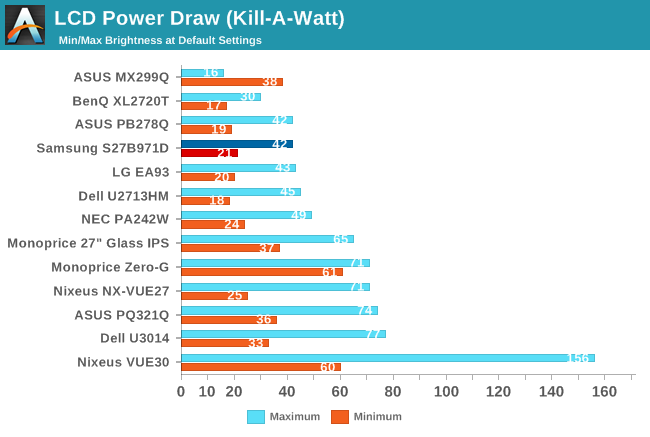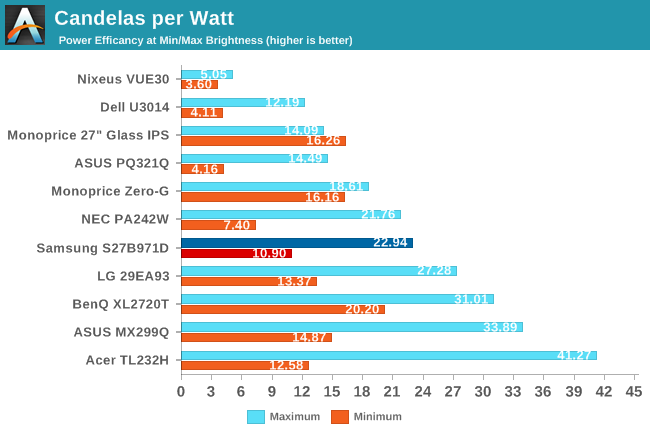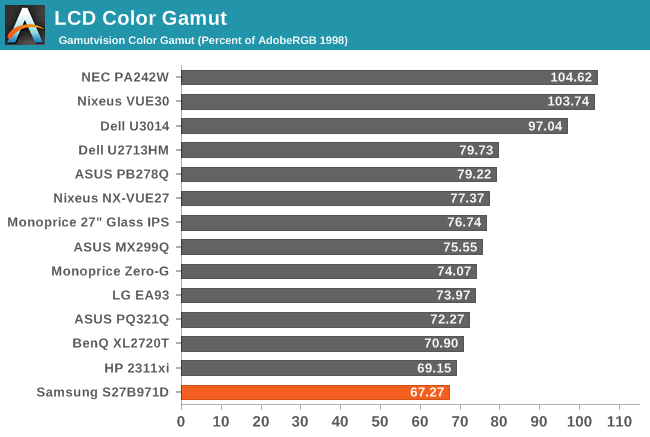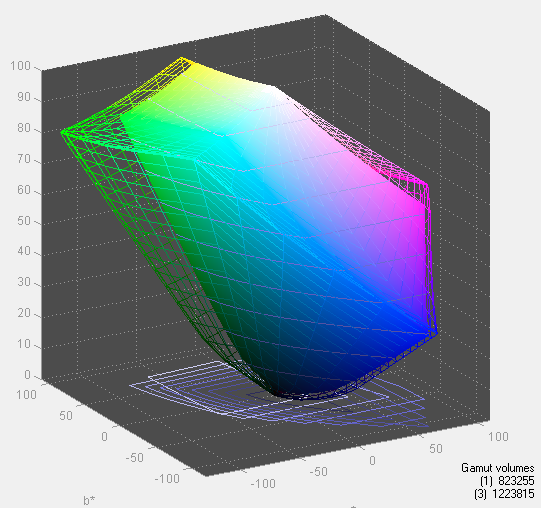Samsung S27B971D Monitor Review
by Chris Heinonen on October 31, 2013 12:00 PM ESTInput lag is tested over HDMI using the Leo Bodnar lag tester. It is limited to 1080p but it provides consistent, repeatable results that anyone can duplicate. A scaler can also be designed to introduce very little lag if implemented correctly so native resolution might provide better results, but it would be a slight difference (unless a poor/slow scaler is used).
Tested this way the Samsung S27B971D averages 26.3ms of lag. This is competitive with other 27” WQHD monitors that have produced 22.53 – 35.97ms of lag. Basically if you find any 27” WQHD monitor to be too slow, the Samsung won’t change your mind. I found nothing wrong with the overall gaming performance in my testing.

Power Use
Power draw from a Kill-A-Watt is reasonable on the Samsung with 21 watts at minimum backlight and 42 watts at maximum. On a candelas-per-square-inch-per-watt basis it comes in as being one of the most efficient monitors at maximum backlight and middle of the pack at minimum backlight. Now that virtually everyone uses LEDs, even for wide gamut displays, there probably won’t be as much difference here as there used to be.


Color Gamut
This is a bit interesting to me. In the sRGB mode the Samsung S27B971D falls short of the full sRGB gamut. It fills 67% of the AdobeRGB gamut, and not the 69% that we expect from sRGB. It’s a small difference but it is still a difference. If we switch to the standard color mode instead of sRGB then the gamut is larger. I ran the pre-calibration numbers, did a calibration in both modes, and ran the post-calibration numbers and found that the sRGB preset was far superior in the end. So while the gamut might come up just slightly low, it’s better than being over-saturated all around. In practice, very few people if any will notice the difference between 67% and 69%, as what we’re really looking for are displays that use significantly less than the sRGB gamut.












52 Comments
View All Comments
Death666Angel - Friday, November 1, 2013 - link
You realize the monitor here has 240 vertical pixels more than the 1200 you speak of?NicoleJNavarro - Monday, November 4, 2013 - link
hii
EJS1980 - Monday, November 4, 2013 - link
For that price I got 2 Overlord Tempest OC's, and overclocked them to 120Hz. Nothing beats 1440p at 120Hz....NOTHING!!!djscrew - Friday, November 1, 2013 - link
here here!NicoleJNavarro - Monday, November 4, 2013 - link
my best frends mum just got a year 2012 Mitsubishi i-MiEV by working from a home pc... browse this site
twizzlebizzle22 - Thursday, October 31, 2013 - link
Tl;Dr average monitor... High priceSamus - Thursday, October 31, 2013 - link
Seriously, you can get the Dell or HP 27" IPS or PLS models on sale for half the price, or in other words, you could have TWO excellent 2560x1440 monitors for the price of the Samsung.JarredWalton - Thursday, October 31, 2013 - link
Except for the uniformity aspect, which Samsung does very well. But yes, it's priced too high for what you get in our opinion.Spoelie - Friday, November 1, 2013 - link
What I don't get is why you didn't measure or use the "Calibrated" preset. Everything is done in sRGB.cheinonen - Sunday, November 3, 2013 - link
Before I chose a preset I measured the grayscale and color saturations on all preset modes. sRGB and Calibrated were practically identical. However, sRGB allows for a brightness setting while it is preset on Calibrated. Because dE2000 will factor in a target brightness (200 cd/m^2 in our case), this would then cause Calibrated to have higher error levels overall. If we didn't have a target light level it might have been slightly better but you also only could use the monitor at 260 cd/m^2 or so of brightness.